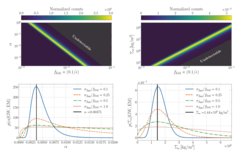First realistic parameter estimation of gravitational-wave sources embedded in accretion disks
New study allows to probe the properties of accretion disks inaccessible so far
The rich phenomenology of accretion disks—ubiquitous in galaxies, black holes, and stars—is difficult to capture with first-principles models. Traditional observations of their electromagnetic emission are also limited. But any masses embedded in an accretion disk can be considerably perturbed by the disk leaving a detectable imprint in the gravitational waves. These ripples in space-time encode information about the motion of their sources. The authors show that one can infer properties of the accretion disk from gravitational-wave observations of compact objects spiraling into accreting black holes. Thus, future space-borne gravitational-wave detectors have the potential to probe accretion disk physics beyond what is achievable so far.
Paper abstract
Gravitational wave observations of extreme mass ratio inspirals (EMRIs) offer the opportunity to probe the environments of active galactic nuclei (AGN) through the torques that accretion disks induce on the binary. Within a Bayesian framework, we study how well such environmental effects can be measured using gravitational wave observations from the Laser Interferometer Space Antenna (LISA). We focus on the torque induced by planetary-type migration on quasi-circular inspirals, and use different prescriptions for geometrically-thin and radiatively-efficient disks. We find that LISA could detect migration for a wide range of disk viscosities and accretion rates, for both α and β disk prescriptions. For a typical EMRI with masses 50M⊙+106M⊙, we find that LISA could distinguish between migration in α and β disks and measure the torque amplitude with ∼20% relative precision. Provided an accurate torque model, we also show how to turn gravitational-wave measurements of the torque into constraints on the disk properties. Furthermore, we show that, if an electromagnetic counterpart is identified, the multimessenger observations of the AGN-EMRI system will yield direct measurements of the disk viscosity. Finally, we investigate the impact of neglecting environmental effects in the analysis of the gravitational-wave signal, finding 3-sigma biases in the primary mass and spin, and showing that ignoring such effects can lead to false detection of a deviation from general relativity. This work demonstrates the scientific potential of gravitational observations as probes of accretion-disk physics, accessible so far through electromagnetic observations only.

Lower panel: Posterior distribution of the disk viscosity (left) or disk surface density (right), assuming that the disk accretion rate is determined with uncertainty σfEdd through an EM follow-up observation.
